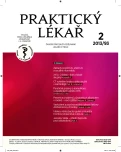Vascular and psychosocial risk factor of Alzheimer's disease
Authors:
J. Povová 1; P. Ambroz 1; H. Tomášková 1; M. Bar 2; O. Šerý 3; J. Štěpánová 4; K. Vařechová 1; V. Janout 1
Authors‘ workplace:
Lékařská fakulta Ostravské univerzity v Ostravě Ústav epidemiologie a ochrany veřejného zdraví Vedoucí: prof. MUDr. Vladimír Janout, CSc.
1; Lékařská fakulta Ostravské univerzity v OstravěKatedra interních oborů LFVedoucí: MUDr. Ivo Valkovský
2; Přírodovědecká fakulta Masarykovy univerzity v BrněÚstav biochemieŘeditel: doc. Ing. Martin Mandl, CSc.
3; Krajská nemocnice Tomáše Bati, a. s., ZlínŘeditel: MUDr. Bohuslav Škubal, CSc.
4
Published in:
Prakt. Lék. 2013; 93(2): 59-62
Category:
Of different specialties
Overview
Alzheimer's disease (AD) is the most common form of dementia. It is a degenerative incurable terminal disease. AD affects a high percentage of persons all over the world. Aetiology is still unknown. Numerous etiological factors of AD have already been discovered. Pilot evaluation of 307 cases and 96 controls from mental hospitals in project “Epidemiology and genetic of Alzheimer´s disease” provided following results. The questionnaires contain questions about identification, education, lifestyle, vascular risk factors, hobbies, occupation, incidence of the disease in the family, results of Minimental State Examination (MMSE). Though there are the first results from pilot part of study, some questions are presented. Results suggest, that persons with AD have often a cardiovascular disease and head injury in history. Conversely they did not have diabetes mellitus, hypertension and cerebrovascular disease.
Keywords:
dementia – Alzheimer's disease – risk factors
Sources
1. Akomolafe A, Beiser A, Meigs JB, et al. Diabetes mellitus and risk of developing Alzheimer disease: results from the Framingham Study. Arch Neurol 2006; 63: 1551–1555.
2. Arvanitakis Z, Wilson RS, Bienias JL, et al. Diabetes mellitus and risk of Alzheimer disease and decline in cognitive function. Arch Neurol 2004; 61: 661–666.
3. Beeri MS, Rapp M, Silverman JM, et al. Coronary artery disease is associated with Alzheimer disease neuropathology in APOE4 carriers. Neurology 2006; 66: 1399–1404.
4. Fratiglioni L, Vitanen M, von Strauss E, et al. Very old women at highest risk of dementia and Alzheimer´s disease: Incidence data from the Kungnsholmen Project, Stockholm. Neurology 1997; 48: 132–138.
5. Honig LS, Tang MX, Albert S, et al. Stroke and the risk of Alzheimer disease. Arch Neurol 2003; 60: 1707–1712.
6. Höschl C, a kol. Alzheimerova choroba. 1. vyd. Praha: Galén 1999.
7. Irie F, Fitzpatrick AL, Lopez OL, et al. Enhanced risk for Alzheimer disease in persons with type 2 diabetes and APOE e4: the Cardiovascular Health Study Cognition Study. Arch Neurol 2008; 65: 89–93.
8. Jirák R. Diagnostika a terapie Alzheimerovy choroby. Neurológia pre prax 2008; 4: 224–227.
9. Kivipelto M, Helkala EL, Laakso MP, et al. Midlife vascular risk factors and Alzheimer’s disease in later life: longitudinal, population based study. BMJ 2001; 322: 1447–1451.
10. Launer LJ, Ross GW, Petrovitch H, et al. Midlife blood pressure and dementia: the Honolulu-Asia aging study. Neurobiol Aging 2000; 21: 49–55.
11. Newman AB, Fitzpatrick AL, Lopez O, et al. Dementia and Alzheimer’s disease incidence in relationship to cardiovascular disease in the Cardiovascular Health Study cohort. J Am Geriatr Soc 2005; 53: 1101–1107.
12. Ngandu T, von Strauss E, Helkala EL, et al. Education and dementia: what lies behind the association? Neurology 2007; 69: 1442–1450.
13. Petitti DB, Crooks VC, Buckwalter JG, Chiu V. Blood pressure levels before dementia. Arch Neurol 2005; 62: 112–116.
14. Qiu C, Bäckman L, Winblad B, et al. The influence of education on clinically diagnose dementi: incidence and mortality data from Kungsholmen project. Arch Neurol 2001; 58: 2034–2039.
15. Qiu C, Winblad B, Fratiglioni L. The age-dependent relation of blood pressure to cognitive function and dementia. Lancet Neurol 2005; 4: 487–499.
16. Skoog I, Lernfelt B, Landahl S, et al. 15-year longitudinal study of blood pressure and dementia. Lancet 1996; 347: 1141–1145.
17. Vališ M, Kalnická D. Novinky ve farmakoterapii demencí. Neurologie pro praxi 2011; 12(1): 33–36.
18. Vermeer SE, Prins ND, den Heijer T, et al. Silent brain infarcts and the risk of dementia and cognitive decline. N Engl J Med 2003; 348: 1215–1222.
19. Vysoká škola chemicko-technologická v Praze. Neurofyziologie II. [online]. 2010-04-16 [cit. 2012-10-27]. Dostupný na: http://tresen.vscht.cz/kot/wp-content/uploads/fyziologie/mod-NEUROFYZIOLOGIE-II2007.pdf
20. WHO. Duševní poruchy a poruchy chování. Mezinárodní klasifikace nemocí, 10. revize, Psychiatrické centrum Praha 2000; 60–62.
Labels
General practitioner for children and adolescents General practitioner for adultsArticle was published in
General Practitioner

2013 Issue 2
- Memantine in Dementia Therapy – Current Findings and Possible Future Applications
- Memantine Eases Daily Life for Patients and Caregivers
- What Effect Can Be Expected from Limosilactobacillus reuteri in Mucositis and Peri-Implantitis?
- Metamizole at a Glance and in Practice – Effective Non-Opioid Analgesic for All Ages
Most read in this issue
- Cardiac computed tomography and its importance in cardiology K
- Paretic symptoms and complications in aseptic CNS infections
- Helicobacter pylori infection and immune thrombocytopenic purpura – a case report
- Vascular and psychosocial risk factor of Alzheimer's disease
